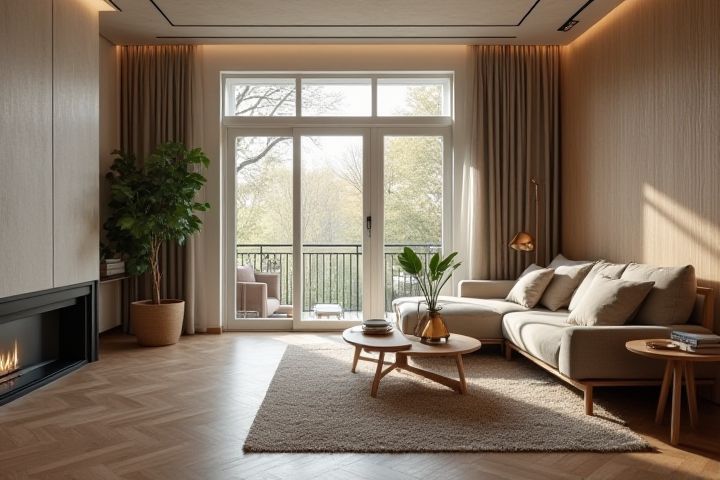
To efficiently soundproof your house, start by sealing gaps in doors and windows using weatherstripping or acoustical caulk to reduce noise leakage. Installing heavy curtains or soundproof blinds can significantly dampen external sounds while enhancing your home's aesthetic. Consider using soundproofing materials such as mass-loaded vinyl (MLV) or acoustic panels on walls to absorb sound waves effectively. Adding rugs or carpets can help minimize noise transmission on floors, especially in multi-story homes. For optimal results, you might also explore insulating your walls and ceilings with soundproof drywall for a more permanent solution against unwanted noise.
How To Soundproof A House Efficiently
Insulate walls and ceilings
Insulating walls with soundproofing materials, such as mineral wool or acoustic panels, can significantly reduce noise transmission, achieving a sound reduction of up to 50%. Ceilings can benefit from installing resilient channels, which decouple the drywall from the structural frame, promoting a further 10-20% reduction in sound transfer. Consider adding dense insulation like fiberglass or cellulose between wall studs for enhanced performance, offering sound absorption rates that effectively lower decibel levels. For the most effective results, ensure all gaps and seams are sealed with acoustical caulk, preventing sound leaks and maximizing your soundproofing strategy.
Use acoustic panels
Acoustic panels are an effective solution for soundproofing your house, especially in spaces where noise reduction is crucial, such as home theaters or recording studios. These panels are typically made from dense foam or specialized materials that absorb sound waves, reducing echo and ambient noise. Installing acoustic panels strategically on walls and ceilings can significantly decrease sound transmission, with some products demonstrating a reduction of up to 80% in noise levels. To maximize their effectiveness, ensure you cover areas where sound reflects most, such as corners and flat surfaces, optimizing your space for a quieter environment.
Upgrade to soundproof windows
Upgrading to soundproof windows is a highly effective method for enhancing your home's acoustical insulation. These specialized windows typically feature multiple layers of glass with varying thicknesses, effectively reducing noise transmission from outside. By incorporating sound-dampening frames and airtight seals, you can considerably minimize external disturbances, ensuring a quieter indoor environment. Investing in soundproof windows not only improves your home's comfort but can also boost its overall value and energy efficiency.
Install solid-core doors
Installing solid-core doors can significantly enhance soundproofing in your home, as they are denser and heavier than hollow-core options, reducing noise transmission. A solid-core door typically weighs between 40 to 60 pounds, making it an effective barrier against sound. Ensure proper sealing around the edges with weather stripping; this can improve sound insulation by preventing sound leakage through gaps. When combined with sound-absorbing materials in surrounding rooms, your solid-core door will contribute to a quieter, more peaceful indoor environment.
Add weatherstripping to gaps
Adding weatherstripping to gaps around doors and windows is a crucial step in soundproofing your house. This affordable solution effectively seals off spaces where sound may leak, minimizing noise intrusion from the outside. You can choose from various types of weatherstripping materials, such as foam tape, V-strip, or door sweeps, each designed to optimize your home's acoustic barrier. By ensuring a tight seal, you enhance your indoor environment, creating a more peaceful living space conducive to relaxation or productivity.
Utilize thick rugs and carpets
Utilizing thick rugs and carpets is a highly effective method for soundproofing your house, as they act as sound absorbers that reduce echo and noise transmission. Installing plush area rugs can decrease sound vibration levels by up to 30%, making your living space much quieter. When placed strategically in high-traffic areas and on hard flooring surfaces, rugs can significantly dampen footstep noise and ambient sounds from below. To enhance this effect, consider layering rugs or using pads underneath them, which can provide additional insulation against sound.
Hang heavy curtains or blinds
Hang heavy curtains or blinds to significantly reduce noise infiltration in your home. Opt for fabric with a high denier count, as these materials can absorb sound waves effectively. Ensure that your curtains or blinds extend from ceiling to floor, covering the entire window area, to maximize coverage and minimize gaps. Using multiple layers, such as combining sheer and blackout curtains, can further enhance your soundproofing efforts for a quieter living environment.
Position furniture strategically
Positioning furniture strategically can significantly enhance soundproofing in your house. Utilize heavy furniture like bookshelves or couches against shared walls to absorb sound energy, reducing audio transmission between spaces. Consider placing rugs or carpets on hardwood or tile floors, as they can dampen noise from footsteps and echoes, improving overall acoustics. Remember to avoid placing large furniture pieces in front of windows, as this can block natural light while failing to effectively mitigate noise from outside.
Seal cracks and crevices
Sealing cracks and crevices is crucial for effective soundproofing, as even small openings can allow significant noise to enter. Use acoustic caulk or foam sealant to fill gaps around windows, doors, and walls--typical sound leaks often range from 1/16 inch to 1/4 inch wide. You can also apply weatherstripping or door sweeps to enhance sound isolation around movable parts. By addressing these openings, you can reduce sound transmission by up to 80%, creating a quieter living environment.
Apply soundproof paint
Applying soundproof paint can significantly reduce noise levels in your home due to its dense and heavy composition. Typically, this specialized paint contains materials like glass particles and rubber, providing a barrier that absorbs sound waves. Covering approximately 350 square feet per gallon, you should consider multiple coats for optimal soundproofing effects, especially in high-traffic areas. For best results, ensure the surface is clean and smooth before application, enhancing adhesion and effectiveness in noise reduction.
